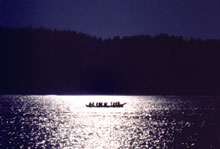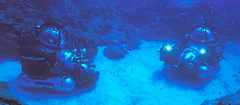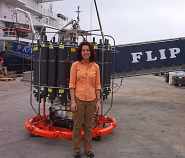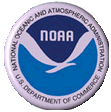|
Ocean Exploration
NOAA Ocean Explorer
http://oceanexplorer.noaa.gov
This web site is sponsored by the US Government NOAA Office of Ocean Exploration. It is a most extensive site with details of a range of recent ocean exploration programs on-line. Each expedition is presented with a great deal of detail, including mission plans, mission logs, and explorer details (biographies of the explorers) and, most importantly for teachers, well constructed lesson plans. There is a great detail available to both teachers and students. The information is easy to access quickly but for those of you too busy to download from the web, the first two seasons of expeditions are available on a CD.
Classroom Exploration of Oceans
http://www.coexploration.org/ceo/
Another US site and one that is sponsored by a range of organizations. This a workshop based web site that requires registration. There is an amazing amount of material here and more to come over 2003. Scientific experts present nine keynote lectures and there is a great deal of chat-room style open dialog.
As with the Office of Ocean Exploration site, CD's are also available (limited number) - the Classroom Exploration of Oceans CD is packed with video interviews that would bring the human face of ocean exploration into the classroom and do so in a way that truly reflects the excitement of this work.
|


|
| |
|
|
Ocean Exploration - Chapter Two
In September we began a series of Habitat of the Month articles featuring oceans with Oceans - Chapter 1. This month we pick-up the oceans theme again with Chapter 2 and a continued focus on exploration of our oceans.
Teacher at Sea - Debra Brice, USA
Hi, my name is Debra Brice and I am an 8th grade science teacher at San Marcos Middle School in California, USA. I have been selected as a NOAA (National Oceanographic and Atmospheric Administration) 'Teacher at Sea' along with another teacher from Chile.
The ship on which we will be travelling is a Scripps Institution of Oceanography R/V Roger Revelle. The chief scientist for this research cruise, Dr. Robert Weller, is from WHOI (Woods Hole Oceanographic Institution). The Chilean teacher and I will be flying to Ecuador at the beginning of November to meet the ship and leave Manta, Ecuador on November 9th. We steam 800 miles south-west off the coast of Chile to some carry out physical Oceanographic research related to the deployment of a Weather and Acoustical Buoy for WHOI, then we go in towards the coast to deploy a Tsunami detection Buoy for NOAA. |

Debra Brice in front of the R/V Revelle
on Sept 23, 2003
|
Science Goals and Objectives for WHOI Buoy
The Long Term Evolution and Coupling of the Boundary Layers Study (referred to as the Stratus Project) is an effort to obtain a reliable multi-year dataset of meteorological and subsurface measurements beneath the stratus cloud deck off the coast of Chile and Peru. This data will improve our understanding of the role of clouds in ocean-atmosphere coupling. This project is part of the Eastern Pacific Investigation of Climate (EPIC), a NOAA-funded Climate Variability (CLIVAR) study.
The purpose of this cruise was to recover and then deploy a new well-instrumented surface mooring under the stratocumulus clouds found off Chile and Peru in the vicinity of 200S and 850W. The mooring has been deployed for three years as a component of the Enhanced Monitoring element of the Eastern Pacific Investigation of Climate (EPIC) programs. The first deployment was in October 2000 (Stratus 1). The buoy was recovered and a new buoy (Stratus 2) deployed in October 2001. In October 2002, Stratus 2 was recovered and Stratus 3 deployed. Cruises for recovery and redeployment will follow each October.
Cruise dates are:
-
I leave for Manta November 4th and spend 4 days in Manta.
-
November 9th - The R/V Roger Revelle departs from Manta. We will be at sea until 26 November, return to Arica ,Chile then fly home.
Students will be able to follow me on the TAS website during my whole trip, they will be able to ask questions and participate in experiments using near real time data. The Chilean teacher and I will be interviewing scientists and crew members in live webcasts as well as participating the science program. We will be working with geography classes as well as science classes and will be e-mailing and answering student questions daily as well as developing lesson plans. My e-mail on the ship will be Debra.Brice@noaa.gov.
I hope you and your students can join me on the web. For more information and educations resources:
|
|
|
Site of the Month
NOAA Ocean Explorer http://oceanexplorer.noaa.gov
This web site is sponsored by the US Government NOAA Office of Ocean Exploration. It is a most extensive site with details of a range of recent ocean exploration programs on-line. The key to this wonderful site is the great detail that is available to both teachers and students. The information is easy to access quickly but for those of you too busy to download from the web, the first two seasons of expeditions are available on a free CD.
·Each expedition is presented with a great deal of detail, including mission plans, mission logs, and explorer details (biographies of the explorers). As well as a great collection of still images and maps, most expeditions provide small video clips. Most expeditions have well constructed lesson plans that are presented as downloadable pdf's. An excellent resource for teachers. |

|
|
|
|